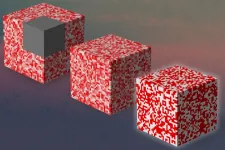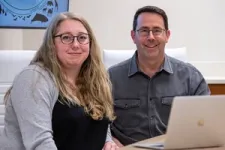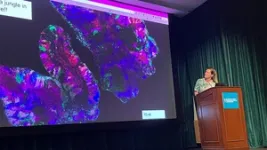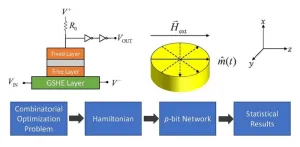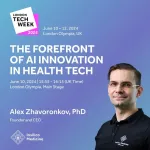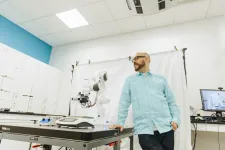(Press-News.org) CAMBRIDGE, MA — Maybe you can’t tell a book from its cover, but according to researchers at MIT you may now be able to do the equivalent for materials of all sorts, from an airplane part to a medical implant. Their new approach allows engineers to figure out what’s going on inside simply by observing properties of the material’s surface.
The team used a type of machine learning known as deep learning to compare a large set of simulated data about materials’ external force fields and the corresponding internal structure, and used that to generate a system that could make reliable predictions of the interior from the surface data.
The results are being published in the journal Advanced Materials, in a paper by doctoral student Zhenze Yang and professor of civil and environmental engineering Markus Buehler.
“It’s a very common problem in engineering,” Buehler explains. “If you have a piece of material — maybe it’s a door on a car or a piece of an airplane — and you want to know what’s inside that material, you might measure the strains on the surface by taking images and computing how much deformation you have. But you can’t really look inside the material. The only way you can do that is by cutting it and then looking inside and seeing if there’s any kind of damage in there.”
It's also possible to use X-rays and other techniques, but these tend to be expensive and require bulky equipment, he says. “So, what we have done is basically ask the question: Can we develop an AI algorithm that could look at what’s going on at the surface, which we can easily see either using a microscope or taking a photo, or maybe just measuring things on the surface of the material, and then trying to figure out what’s actually going on inside?” That inside information might include any damages, cracks, or stresses in the material, or details of its internal microstructure.
The same kind of questions can apply to biological tissues as well, he adds. “Is there disease in there, or some kind of growth or changes in the tissue?” The aim was to develop a system that could answer these kinds of questions in a completely noninvasive way.
Achieving that goal involved addressing complexities including the fact that “many such problems have multiple solutions,” Buehler says. For example, many different internal configurations might exhibit the same surface properties. To deal with that ambiguity, “we have created methods that can give us all the possibilities, all the options, basically, that might result in this particular [surface] scenario.”
The technique they developed involved training an AI model using vast amounts of data about surface measurements and the interior properties associated with them. This included not only uniform materials but also ones with different materials in combination. “Some new airplanes are made out of composites, so they have deliberate designs of having different phases,” Buehler says. “And of course, in biology as well, any kind of biological material will be made out of multiple components and they have very different properties, like in bone, where you have very soft protein, and then you have very rigid mineral substances.”
The technique works even for materials whose complexity is not fully understood, he says. “With complex biological tissue, we don’t understand exactly how it behaves, but we can measure the behavior. We don’t have a theory for it, but if we have enough data collected, we can train the model.”
Yang says that the method they developed is broadly applicable. “It is not just limited to solid mechanics problems, but it can also be applied to different engineering disciplines, like fluid dynamics and other types.” Buehler adds that it can be applied to determining a variety of properties, not just stress and strain, but fluid fields or magnetic fields, for example the magnetic fields inside a fusion reactor. It is “very universal, not just for different materials, but also for different disciplines.”
Yang says that he initially started thinking about this approach when he was studying data on a material where part of the imagery he was using was blurred, and he wondered how it might be possible to “fill in the blank” of the missing data in the blurred area. “How can we recover this missing information?” he wondered. Reading further, he found that this was an example of a widespread issue, known as the inverse problem, of trying to recover missing information.
Developing the method involved an iterative process, having the model make preliminary predictions, comparing that with actual data on the material in question, then fine-tuning the model further to match that information. The resulting model was tested against cases where materials are well enough understood to be able to calculate the true internal properties, and the new method’s predictions matched up well against those calculated properties.
The training data included imagery of the surfaces, but also various other kinds of measurements of surface properties, including stresses, and electric and magnetic fields. In many cases the researchers used simulated data based on an understanding of the underlying structure of a given material. And even when a new material has many unknown characteristics, the method can still generate an approximation that’s good enough to provide guidance to engineers with a general direction as to how to pursue further measurements.
As an example of how this methodology could be applied, Buehler points out that today, airplanes are often inspected by testing a few representative areas with expensive methods such as X-rays because it would be impractical to test the entire plane. “This is a different approach, where you have a much less expensive way of collecting data and making predictions,” Buehler says. “From that you can then make decisions about where do you want to look, and maybe use more expensive equipment to test it.”
To begin with, he expects this method, which is being made freely available for anyone to use through the website GitHub, to be mostly applied in laboratory settings, for example in testing materials used for soft robotics applications.
For such materials, he says, “We can measure things on the surface, but we have no idea what’s going on a lot of times inside the material, because it’s made out of a hydrogel or proteins or biomaterials for actuators, and there’s no theory for that. So, that’s an area where researchers could use our technique to make predictions about what’s going on inside, and perhaps design better grippers or better composites,” he adds.
The research was supported by the U.S. Army Research Office, the Air Force Office of Scientific Research, the GoogleCloud platform, and the MIT Quest for Intelligence.
END
Deep-learning system explores materials’ interiors from the outside
A new method could provide detailed information about internal structures, voids, and cracks, based solely on data about exterior conditions.
2023-04-28
ELSE PRESS RELEASES FROM THIS DATE:
Solving computationally complex problems with probabilistic computing
2023-04-28
According to computational complexity theory, mathematical problems have different levels of difficulty in the context of their solvability. While a classical computer can solve some problems (P) in polynomial time — i.e., the time required for solving P is a polynomial function of the input size — it often fails to solve NP problems that scale exponentially with the problem size and thus cannot be solved in polynomial time. Classical computers based on semiconductor devices are, therefore, inadequate ...
York University leads $318.4M first-of-kind inclusive next-gen technology research initiative
2023-04-28
TORONTO, April 28, 2023 — Is an equitable world that includes humans and machines possible? York University researchers believe it must be and have set out to make it so through a first of its kind interdisciplinary research initiative called Connected Minds: Neural and Machine Systems for a Healthy, Just Society.
From universities to industries, hospitals and policymakers, artists and Indigenous communities, York’s Connected Minds will engage 50+ community partners and research collaborators over seven years supported by a historic $318.4 million in funding. Connected Minds has received a combined $105.7 million from the Canada First Research ...
Shocking implications of electric fishes’ tailless sperm
2023-04-28
Betting on tailless sperm that evolved from brave swimmers to hapless floaters seems like a crazy evolutionary gamble, but a group of fish seems to have done just that. Understanding that tradeoff holds promise to shed light on human disease and shake up biology lessons on traditional gender roles.
Michigan State University associate professor of integrative biology Jason Gallant and colleagues are using nearly $1 million from the National Science Foundation to understand the implications from a small African fish which ...
Insilico Medicine founder and CEO Alex Zhavoronkov, Ph.D., presents at LSX World Congress
2023-04-28
Alex Zhavoronkov, PhD, founder and CEO of Insilico Medicine (“Insilico”) will present at the 9th LSX World Congress happening in London May 3 and May 4. Zhavoronkov, an expert in generative artificial intelligence (AI) for drug discovery, will present on May 3, 2:45pm (London time) on “‘Death By Pilot’” to Asset Licensing – the Evolution of Pharma-AIDD Partnerships” as part of the Biotech Growth CEO Forum and on May 4, 9:30am (London time) on “Building a Galvanizing ...
Texas Neurologist and Professor elected New American Academy of Neurology President
2023-04-28
MINNEAPOLIS – The American Academy of Neurology (AAN), the world’s largest professional association of neurologists and neuroscience professionals, has elected as its 38th president Carlayne E. Jackson, MD, FAAN, a neurologist, researcher and professor of neurology and otolaryngology at the University of Texas Health Science Center at San Antonio. Jackson succeeds Orly Avitzur, MD, MBA, FAAN, who completed her two-year term as president during the recent AAN Annual Meeting.
“It’s humbling to have been chosen by my colleagues to follow such talented and dedicated individuals ...
First comprehensive care plan to prevent preeclampsia published in the American Journal of Obstetrics and Gynecology
2023-04-28
Recommendations for high-risk expecting parents and health care providers to promote the prevention of preeclampsia, a leading cause of pregnancy-related death in the United States
SAN FRANCISCO - April 28, 2023 – A new special report published in the American Journal of Obstetrics and Gynecology (AJOG) provides a groundbreaking approach to preeclampsia, one of the most pressing issues in maternal health today, and will translate the prediction of risk into prevention of disease.
The report, ...
Max-difference maximization criterion: A feature selection method for text categorization
2023-04-28
For text categorization, it is necessary to select a set of features(terms) with high discrimination by using feature selection. In text feature selection, Accuracy2(ACC2)treats terms with same absolute document rate difference but different discrimination equally, which is unreasonable. Existing improved methods (normalized difference measure(NDM), max-min ratio(MMR)and trigonometric comparison measure(TCM)) based on ACC2 may confuse the importance of rare and sparse terms on account of challenge for parameter selection.
To solve the problems, a research team led by Li Zhang published their new research on 15 February 2023 in Frontiers of Computer Science co-published ...
U of T receives $200-million grant to support Acceleration Consortium's ‘self-driving labs’ research
2023-04-28
The University of Toronto has been awarded a $200-million grant from the Canada First Research Excellence Fund (CFREF) to revolutionize the speed and impact of scientific discovery through its Acceleration Consortium. The funding – the largest federal research grant ever awarded to a Canadian university – will support the consortium’s work on “self-driving labs” that combine artificial intelligence, robotics and advanced computing to discover new materials and molecules in a fraction of the usual time and cost. Applications include everything from life-saving medications ...
Scientists identify antivirals that could combat emerging infectious diseases
2023-04-28
A new study has identified potential broad-spectrum antiviral agents that can target multiple families of RNA viruses that continue to pose a significant threat for future pandemics. The study, led by Gustavo Garcia Jr. in the UCLA Department of Molecular and Medical Pharmacology, tested a library of innate immune agonists that work by targeting pathogen recognition receptors, and found several agents that showed promise, including one that exhibited potent antiviral activity against members of RNA viral families.
The ongoing SARS-CoV-2 pandemic, which ...
Study finds ChatGTP outperforms physicians in providing high-quality, empathetic advice to patient questions
2023-04-28
La Jolla, Calif. (April 28, 2023) — There has been widespread speculation about how advances in artificial intelligence (AI) assistants like ChatGPT could be used in medicine.
A new study published in JAMA Internal Medicine led by Dr. John W. Ayers from the Qualcomm Institute within the University of California San Diego provides an early glimpse into the role that AI assistants could play in medicine. The study compared written responses from physicians and those from ChatGPT to real-world health questions. A panel of licensed healthcare professionals preferred ChatGPT’s responses 79% of the time and rated ChatGPT’s responses as higher quality ...
LAST 30 PRESS RELEASES:
Numbers in our sights affect how we perceive space
SIMJ announces global collaborative book project in commemoration of its 75th anniversary
Air pollution exposure and birth weight
Obstructive sleep apnea risk and mental health conditions among older adults
How talking slows eye movements behind the wheel
The Ceramic Society of Japan’s Oxoate Ceramics Research Association launches new international book project
Heart-brain connection: international study reveals the role of the vagus nerve in keeping the heart young
Researchers identify Rb1 as a predictive biomarker for a new therapeutic strategy in some breast cancers
Survey reveals ethical gaps slowing AI adoption in pediatric surgery
Stimulant ADHD medications work differently than thought
AI overestimates how smart people are, according to HSE economists
HSE researchers create genome-wide map of quadruplexes
Scientists boost cell "powerhouses" to burn more calories
Automatic label checking: The missing step in making reliable medical AI
Low daily alcohol intake linked to 50% heightened mouth cancer risk in India
American Meteorological Society announces Rick Spinrad as 2026 President-Elect
Biomass-based carbon capture spotlighted in newly released global climate webinar recording
Illuminating invisible nano pollutants: advanced bioimaging tracks the full journey of emerging nanoscale contaminants in living systems
How does age affect recovery from spinal cord injury?
Novel AI tool offers prognosis for patients with head and neck cancer
Fathers’ microplastic exposure tied to their children’s metabolic problems
Research validates laboratory model for studying high-grade serous ovarian cancer
SIR 2026 delivers transformative breakthroughs in minimally invasive medicine to improve patient care
Stem Cell Reports most downloaded papers of 2025 highlight the breadth and impact of stem cell research
Oxford-led study estimates NHS spends around 3% of its primary and secondary care budget on the health impacts of heat and cold in England
A researcher’s long quest leads to a smart composite breakthrough
Urban wild bees act as “microbial sensors” of city health.
New study finds where you live affects recovery after a hip fracture
Forecasting the impact of fully automated vehicle adoption on US road traffic injuries
Alcohol-related hospitalizations from 2016 to 2022
[Press-News.org] Deep-learning system explores materials’ interiors from the outsideA new method could provide detailed information about internal structures, voids, and cracks, based solely on data about exterior conditions.
